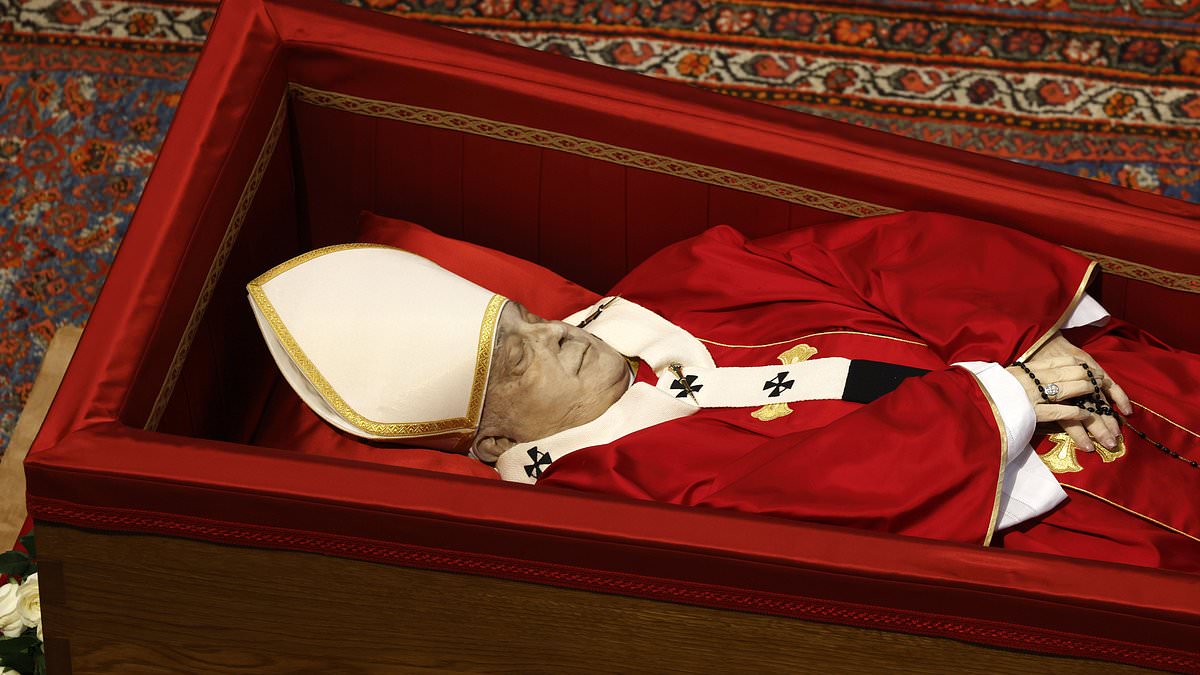Today, the world’s 1.4 billion Catholics are saying goodbye to Pope Francis as his funeral takes place at the Vatican.
World leaders, including US President Donald Trump and Prime Minister Sir Keir Starmer are attending, along with Prince William, who is representing King Charles.
In line with Francis’s wishes, this morning’s ceremony will differ from the funerals of his immediate predecessors.
He will be buried in a single zinc-lined wooden coffin, rather than the customary nested trio of cypress, lead and oak caskets.
And the late pontiff will not be laid to rest in the grottoes beneath St Peter’s Basilica – as is traditional – but in his favourite church, the Santa Maria Maggiore in Rome’s Esquilino neighbourhood.
When will the funeral service start?
Pope Francis’s funeral service will begin at 10am (9am UK time) in the square in front of St Peter’s Basilica.
His coffin will be placed on a dias.
The three-day lying-in-state period came to an end yesterday evening. Hundreds of thousands of people queued to see Francis in his open casket.
At 8pm, his coffin was sealed in a ceremony overseen by Cardinal Kevin Farrell, the Pope’s ‘camerlengo’ (chamberlain) who is running the Vatican until a new pontiff is chosen.
What will happen during the service?
Fifty heads of state and 10 reigning monarchs are among hundreds of thousands of people who are attending Francis’s send-off.
Patriarchs, cardinals, archbishops, bishops and priests from across the world will take part in the funeral.
The funeral is being televised on most major TV networks worldwide, including BBC News and Sky News.
Vatican Media will also be livestreaming the funeral on YouTube and official websites.
In line with tradition, Francis’s funeral mass is expected to be presided over by the dean of the College of Cardinals.
The current dean is 91-year-old Cardinal Giovanni Battista Re, 91.
At the funeral of Pope John Paul II in 2005, the sermon was delivered by German Cardinal Joseph Ratzinger, who offered what many thought was a stirring elocution on the late pope’s life and legacy.
Eleven days later, Ratzinger would be elected as Pope Benedict XVI.
Because of his age, Re cannot enter the conclave and is not a papal contender.
But insiders expect he might still try to offer a guide for his confreres to follow in the way he chooses to describe Francis’ papacy, or in any words he uses to describe the needs of the Catholic Church today.
The funeral for John Paul II brought an estimated 300,000 people together, while about 50,000 attended Pope Benedict’s in 2023.
Different language will be used during the service. Francis will be called ‘Bishop of Rome’, ‘Pope’, ‘Pastor’, or ‘Roman Pontifex’.
Grander titles, such a ‘Supreme Pontiff of the Universal Church’, will be avoided.
There will also be readings from the Bible, as well as hymns and prayers, and Holy Communion will be distributed to the faithful.
The funeral mass will conclude with the Ultima commendatio and the Valedictio, which marks the beginning of the official nine days of mourning for the pope.
The pope’s body will then be taken back into St Peter’s Basilica before making the three-mile journey to Santa Maria Maggiore for his burial.
The procession of his coffin will involve the Vatican’s Swiss Guards.
What will happen at Francis’s burial?
A group of ‘poor and needy’ will be present at the basilica of Santa Maria Maggiore to welcome the coffin, the Vatican said.
He will be interred in the ground, his simple tomb marked with just one word: Franciscus.
The Pope said in his final testament that he wanted to be ‘in the ground; simple, without particular ornamentation’.
People will be able to visit his grave from Sunday morning, the Vatican announced.
At the end of 2023, the Pope revealed he had ‘already prepared’ his tomb in the basilica of Santa Maria Maggiore
The church is one of the four major papal basilicas. Seven popes – from Honorious III in 1216 to Clement IX in 1669 – were buried there.
But the last pope to be buried outside the Vatican was Leo XIII, who died in 1903.
Francis made hundreds of visits to the fifth-century basilica, where he would pray in front a venerated image of the Virgin Mary and baby Jesus.
‘I’ve always had a great devotion to St. Mary Major, even before I became pope,’ Francis said in his 2024 book ‘El Sucesor’ (The Successor), a long interview with journalist Javier Martinez-Brocal
What will happen after Francis’s burial?
Once the Pope is laid to rest, the world will look ahead to the Conclave – the process to choose his successor.
Cardinals from around the world are returning to Rome for the process, which begins no fewer than 15 days and no more than 20 days after a pope’s death.
Only those under the age of 80 – currently some 135 cardinals – are eligible to vote.
Cardinals will be locked inside the Sistine Chapel without access to technology or the outside world until a new pope is chosen by two-thirds majority.
The previous conclave – when Pope Benedict stepped down in 2013 – took just a day, but technically they can last weeks, months or even years.
In modern times, they have tended to only last a few days. If after around two weeks of balloting no new pope has been chosen, cardinals can opt for a majority vote.
